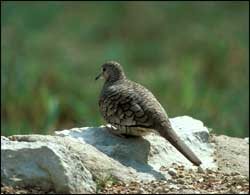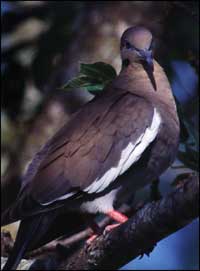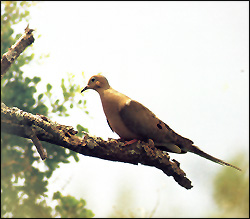Doves and Pigeons
Completely different images come to mind when we hear the words pigeons and doves, but technically no difference exists between the two, and the terms often are used interchangeably. True, those small, fast-flying game birds, able to challenge the shooting skill of any bird hunter, are doves. However, that plump pigeon perched on a building ledge or waddling around the city park looking for a handout is also a dove – a rock dove.
All pigeons and doves are members of the Columbidae family. They have soft, thick plumage in a variety of colors and patterns, with most species displaying some type of iridescent glossing. No seasonal changes in coloration occur, and except for the somewhat duller hues of the female, the sexes are alike.

The small Inca dove adapts readily to urban areas and city parks.
Both sexes share in incubating the eggs and in feeding the newly hatched young a substance called "pigeon milk," which is secreted from the adult's crop. Later the parents regurgitate partially digested food for the young. Adults eat seeds, fruit, and vegetable matter, and a few species also eat a variety of insects and other small invertebrates. Instead of drinking in the typical bird manner – taking a sip, tipping back the head, and allowing the water to trickle down the throat – the pigeon or dove immerses its bill and drinks with sustained sucking.
Of the 289 dove species found in the world, only 8 are considered full-time or part-time residents of Texas. Of these, only the mourning, white-winged, and white-tipped (white-fronted) doves are legal game birds.
The mourning dove, slightly smaller than the whitewing, is the most common and abundant game bird in the United States. It breeds in each of the contiguous forty-eight states and is the only native Texas bird that occurs in all of the state's 254 counties. As long as there is enough water present to allow the bird to drink once a day, the mourning dove can thrive in almost any habitat. This adaptive ability and its year-round multiple-nesting cycle contribute to its abundant numbers. Millions are harvested each year without endangering the population. Its cruising speed of forty miles per hour has enabled it to avoid many a shotgun blast and tests the skill of any bird hunter. When flights of mourning doves and whitewings mix, the mourning dove can be distinguished by its more rapid wing beat, erratic flight path, and pointed tail. Its mournful ooah, cooo, cooo, coo call is made year-round, and from a distance only the three coo's can be heard.
The white-winged dove has a conspicuous white bar on its wings and a long, moderately rounded tail. This popular game bird generally is found south of a line extending from El Paso to Del Rio to San Antonio to Corpus Christi, with the heaviest concentrations in Starr, Cameron, Hidalgo, and Willacy counties. An isolated population is found on Galveston Island, and wandering birds occasionally may be spotted throughout the state in the fall.
Migrating whitewings begin moving into the Lower Rio Grande Valley at the end of March and set up housekeeping in native brush and citrus trees. Their adaptation to citrus trees is helping to counteract some of the losses brought about by the destruction of native brush in the area. Their call, which sounds something like the crowing of a young rooster, is made up of two vocalizations – a harsh coo-uh-CUCK-oo and a "who-cooks-for-you" sound.

Whitewings get their name from the white bars on their wings.
The white-tipped dove, formerly known as the white-fronted dove, is similar in size and shape to the white-wing and may be mistaken for this game bird. However, the whitetip is slightly larger and has cinnamon-colored wing linings. Generally no more than one or two of these solitary birds are seen at a time. A local name for the whitetip is "jug blower" because its call is similar to the song made by blowing across the mouth of an empty bottle or jug.
Another characteristic that may help distinguish the whitetip from the white-wing is its tendency to fly less than ten feet off the ground. It appears to dislike flying and usually takes to the air only when startled. Despite its heavy body and ground-dwelling habits, its flight is swift when it heads for dense cover. Seldom is it seen above the tree tops, where the whitewings fly, but hunters have to be sure of their targets when hunting around brush or citrus groves, as both species are common to these habitats and harvest limits are specific.
The white-tipped dove has adapted so well to the citrus orchards and urban areas that it has had a dramatic population increase during the last decade. Other than citrus orchards, the whitetip also makes its home in the shady woodlands and river thickets, seeking the densest brush it can find. It is difficult to observe because of its rather secretive habits and preference for dense thickets.
Although the increase in population has slightly expanded the whitetip's range, the lower portion of Texas is still the only place in the United States where it resides. It is classed as a migratory species under the Migratory Bird Treaty Act, but the Texas population is migratory only because some fly back and forth across the Rio Grande. Most spend their lives within a three-mile radius, and they prefer to walk instead of fly.
During the 1984-85 dove season, the white-tipped dove (white-fronted dove) became a legal game bird in Texas. It has been hunted for years in Mexico, but until data from studies conducted in Texas indicated it could be hunted in limited numbers without adversely affecting the breeding population, it enjoyed protected status.

The mourning dove is the most common and abundant game bird in the United States.
Rock doves, commonly called domestic pigeons, need no introduction to city dwellers. These twelve- to thirteen-inch birds are extremely variable in color and pattern, ranging from gray to brown to all white with every combination of the three and occasional black markings. All display a white rump patch. Except when the weather is extremely hot or cold, the rock dove's distinctive oo-roo-coo or coo-roo-coo call can be heard year-round.
Their dependence upon handouts in the city and their habit of eating cattle and chicken feed in rural areas make the rock doves seem quite domestic. Few people consider them true wild birds. They generally fly in flocks and do not readily mix with other wild birds. The rock dove has been introduced into almost all parts of the world, and individuals often raise them, as well as other varieties of racing and fancy pigeons.
About half the size of a mourning dove, the small Inca dove has an overall scaly appearance and a long tail with white margins. It displays strong domestic tendencies, choosing to live near humans. It adapts readily to urban areas and city parks and seems to be as much at home eating livestock and poultry feed as eating weed and grass seeds along the roadsides or in pastures.
The bird usually holds its head erect in the dovelike manner, nodding back and forth as it walks. Flight is quick, jerky, and close to the ground. An unusual fluttering sound is made by the wings when the bird flushes. Its call, an often-repeated cooing or two notes on the same pitch with almost equal emphasis, is made almost continuously from dawn to dusk. An occasional coo-co-hoo and a hink-a-doo call also are made.
The ground dove, slightly smaller than the Inca, weighs little more than an ounce and is about the size of a sparrow. Its chunky body has a short, round tail that often is elevated as the bird walks around on the ground, nodding its head. Whereas the Inca dove is more common in urban areas, the ground dove prefers less-populated rural surroundings. Flight of the ground dove is close to the ground. As the bird rises, its wings make a soft, whistling sound, similar to that of the mourning dove, but must less noticeable. Its soft, monotonously repeated call of woo-oo seems to merge into a single wooo with a rising inflection when heard at a distance. This call, primarily heard during the breeding season, is used to designate territory and courtship.
Another Valley resident is the red-billed pigeon. Similar in size to the domestic pigeon, this bird can be distinguished by its reddish bill. It is a high, swift flier and seeks the tallest timber and brush it can find. Except when standing on sand or gravel bars to drink, the red-billed pigeon seldom is seen on the ground. From February into August the male redbill proclaims its territory with its magnificent jungle voice. It starts with an upwelling wooooOOOO, which is quickly followed by three up-cup-a-coo's.
The redbill will fly with whitewings and easily can be misidentified. During the breeding season this pigeon is more likely to be seen singly, in pairs, or in small groups at feeding and watering places. Since the Rio Grande Valley is the redbill's only nesting ground in the United States, its population is restricted to the remaining brush and timber of the area, including some suburban areas. Serious habitat destruction, caused when large native trees are removed or killed, threatens this bird's breeding areas and its continued existence in the Lower Rio Grande Valley.
Unlike the majority of its relatives, which live at low altitudes, the band-tailed pigeon seeks the woodlands of the mountains, breeding between 5,000 and 9,000 feet. It is fairly common in the Guadalupe, Davis, Chinati, and Chisos mountains. If it were not for its preference for mountainous habitat, its tendency to alight in trees, and its yellow feet and legs, the band-tailed pigeon might be mistaken for the slightly smaller rock dove.
This bird is found singly, in pairs, or in small groups during the breeding season, but in fall and winter scattered flocks head for the foothills and open deserts in search of food. The voice of the male has a hollow, owl-like sound. Sitting on a sunny perch atop a dead tree, he hoots his call at irregular intervals in the early morning and late afternoons during the spring and summer.
If these eight species of doves and pigeons are to continue to call Texas home at least part of the year, we must all do our part to make sure their special habitats, especially the native brushlands in the Lower Rio Grande Valley, are protected and perhaps even restored. We cannot allow even one of them to follow the passenger pigeon into extinction.
Ilo
Hiller
1989 – Doves and Pigeons: Introducing Birds to Young
Naturalists. The Louise
Lindsey Merrick Texas Environment
Series, No. 9, pp. 48-51.
Texas A&M University
Press, College Station.